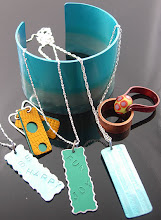A disc cutter has been on my wish list for some time now, and I recently purchased one and am now wondering how I've lived so long without it! The one I chose has a clear perspex top as opposed to the majority I have seen which have metal as the uppermost layer. I'm very glad I made this choice as it's a big advantage to be able to actually see to line up your sheet, and in the case of cutting a circle out within another circle, it's a must to be able to visually line it up.
 A circle punched within a circle
A circle punched within a circleThis particular disc cutter is able to cut circles to the sizes of 1/8"; 3/16"; 1/4"; 5/16"; 7/16"; 1/2"; 5/8" and 3/4" and neatly stores in it's own case.
 Disc Cutter Case
Disc Cutter Case Disc Cutter Set
Disc Cutter SetIt's a simple process to follow, just slip the metal in between the top perspex layer and the bottom metal base, lining it up with the required size hole.
 Sheet Metal inbetween the layers
Sheet Metal inbetween the layersThe cutter punch has a bevelled end and a straight end. Place the straight end into the hole.
 Bevelled Edge
Bevelled Edge Straight Cutting Edge
Straight Cutting Edge  Place staight edge in first
Place staight edge in firstIn all the instructions I have read for disc cutters it mentions only a couple of hits with the hammer is needed. I am using aluminium sheet in mine, so that may be harder to cut than silver sheet, but my experience so far is it requires a lot more than a couple of blows with the hammer, or maybe I'm too light with the hammer as I find it needs several hits before completely cutting through, and the disc will drop through.
 Strike several times with the Hammer
Strike several times with the HammerI found the most challenging part of the process was releasing the cutter punch once the disc has been successfully cut. I've now solved that problem. I looked for a piece of dowel but settled on a small piece of tree branch instead.
 Stick with a straight end
Stick with a straight endI then placed this on the cutter punch and hammered the punch right through. You may need to place a block of wood under the edge of the cutter to give enough height for the punch to safely drop through on a bench top. It should come out quite quickly and easily.
 Releasing the Cutter Punch
Releasing the Cutter PunchI purchased my cutter from
Carol Braden of Mastery Tools on Ebay US. If she doesn't have any listed at the moment I'm sure she wouldn't mind if you emailed enquiring about them.






























